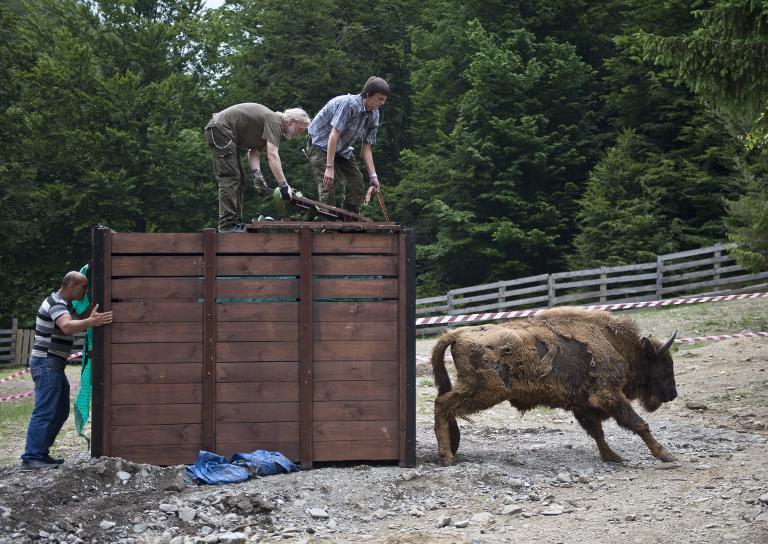
First taste of freedom for 'rewilded' bison in Romania
"I grew up hearing legends about bison that lived here and today we finally see them there," said 60-year-old teacher Elena Dragomir, watching the event near the village of Armenis with a group of her students.
Wildlife experts brought a group of 14 bison from zoos across Europe last week to a 140-hectare (345-acre) Romanian reserve, where they will reacclimatise to natural life before their release into the wilderness in a few months time.
On Saturday, another group of 14 bison was released fully into the Southern Carpathians, a year after they were brought to the reserve to reacclimatise.
The programme, run by Rewilding Europe, WWF Romania and the local community, for now involves only a small group of the huge horned animals, but scientists hope to see herds totalling about 500 bison in the area by 2025.
"This project is not only about saving Europe's largest mammal. It is also about restoring an ecosystem," said Wouter Helmer, director of conservation at Rewilding Europe.
"The bison is grazing meadows, keeping them open for insects, flowers and reptiles. One species makes the world more fun for thousands of others," he said.
- The 'Houdini' of bison -
The bison, however, do not always follow the programme laid out for them. One newcomer quickly broke through a fence and was found peacefully ruminating on a hill dotted with fir trees and forest strawberries a day after his arrival.
"The bison beat us. He already released himself. It wasn't planned, it just happened. It is all part of the rewilding process," said Joep van de Vlasakker, a passionate bison specialist and consultant for Rewilding Europe.
The runaway ungulate, two metres (6.5 feet) tall with big black eyes, has been baptised 'Houdini' after the magician famed for his extraordinary escapes. Aged three, he arrived from the Thoiry zoo, near Paris, with 13 other bison from Switzerland, Germany, Belgium and France.
Houdini will most probably rejoin his fellow bison in the reserve, his escape having been provoked by the stress of the journey to the mountains, the experts said.
"We now leave the bisons in peace as much as possible, the rangers will observe them, they will take good care of them to make the process of adaptation as smooth as possible," said van de Vlasakker.
From the first group of 17 bisons that arrived last year, three died last summer from insect-borne 'bluetongue' disease. But the others "adapted perfectly" and the experts decided they were ready to leave the reserve to live in 59,000 hectares of wilderness in the Tarcu mountains.
Severely depleted by hunting and deforestation, the European bison came close to extinction in the 20th century, surviving thanks to breeding programmes for those kept in captivity.
Today there are more than 5,000 bison in Europe, but only 3,400 live in freedom or semi-freedom, according to wildlife researchers.
- Fewer than black rhinos in Africa -
The biggest population is found in Poland, numbering more than 1,400. Across Romania there are about a hundred.
Helmer said the species was "very threatened", with fewer of them in Europe than there are black rhinos in Africa.
The bison to be returned to nature are selected by DNA testing to determine their genetic wealth, but their personalities are also closely watched because they must be able to eventually form herds.
In Armenis, a village of 2,500 people, Mayor Petru Vela is betting on the bison as a unique tourist attraction.
"The area is of extraordinary beauty but we were missing something special," he said.
The community is working with the WWF and Rewilding Europe to create environmentally friendly business opportunities around the arrival of the bison -- something that has already changed the life of Daniel, an enthusiastic 25-year-old.
"I thought of searching for work abroad when the opportunity to train as a ranger with WWF presented itself," he said.

Legal Disclaimer:
MENAFN provides the
information “as is” without warranty of any kind. We do not accept
any responsibility or liability for the accuracy, content, images,
videos, licenses, completeness, legality, or reliability of the information
contained in this article. If you have any complaints or copyright
issues related to this article, kindly contact the provider above.

















Comments
No comment